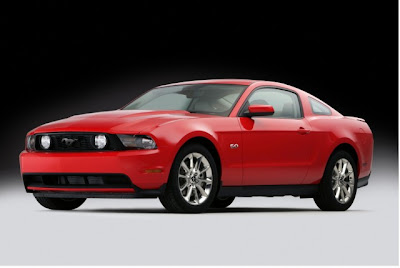
2011 Ford Mustang GT.Furthermore, fuel economy is claimed to be as high as 25 mpg on the highway and 17 mpg in the city for the 6-speed automatic, while the 6-speed manual should return 24 mpg on the highway and 16 mpg in the city.
Key elements of the new 5.0-liter mill is Ford’s Ti-VCT cam-torque-actuated variable camshaft timing system and all-aluminum four-valve-per-cylinder engine design, plus specially designed tubular exhaust headers.
Other changes for the 2011 Ford Mustang GT include specially tuned electric power steering, 11.5-inch front and 11.8-inch rear vented disc brakes, and an enhanced suspension featuring an improved rear lower control arm and stiffened rear stabilizer bushings.The obvious test: a 2011 Mustang GT 5.0.
Back in the early 1980s, when my pre-license self lusted after both cars, the Mustang wasn’t as sexy as the Camaro. This driving position detracts from the car’s perceived sportiness, but greatly aids forward visibility and shrinks the car’s perceived size. In the past the Mustang has sometimes had a more usable rear seat than the Camaro. The Ford’s trunk is a little larger, though,
I frankly don’t care which car is quickest in the quarter. As Baruth attested, big buck German V8s have little or nothing on this powerplant. Ford designed the variable intake and valvetrain for a broad powerband. Compared to the Camaro, the rush starts lower and runs higher—there are nearly another 1,000 rpm between the torque peak and the power peak. The Mustang’s lower curb weight—3,605 vs. 3,860 lbs.—contributes.
In a severe challenge to logic, Ford has installed a first-rate variable-everything DOHC V8 into a car with a live rear axle. Ford claims they ditched the independent rear suspension with which the platform was originally endowed (in Lincoln LS form) for cost reasons. But this is a $35,000+ car. Mustang buyers are apparently willing and able to spend $495 for shiny wheels. I drive on Michigan roads. One caveat: I drove a Mustang with the base, 18-inch wheels (and yet also with the optional 3.73 rear end). The standard brakes are sufficient for off-track driving in the flatlands. Even with the live axle, the Mustang does have some clear advantages over the Camaro in the handling department. It’s a slightly smaller car, and between the driving position and this steering feels like a much smaller car. The Mustang doesn’t ride as smoothly as the Camaro, but it’s still far from punishing. If you lean the same way, then you’ll prefer the Mustang over the Camaro. Remember Ginger smiling? Bonus: aside from the rear suspension, the Mustang is also much more refined.
To ensure the Mustang doesn’t lose out in the latest round of the pony car wars, Ford is reportedly readying a new powerplant for the 2011 car.
With the Dodge Challenger R/T kicking out 372 horsepower and the Chevrolet Camaro SS producing upwards of 422 horsepower, the 2010 Mustang GT is a bit underpowered at only 315.
Code-named ‘coyote’, the new 32-valve powerplant will be shared with the 2011 Ford F-150.